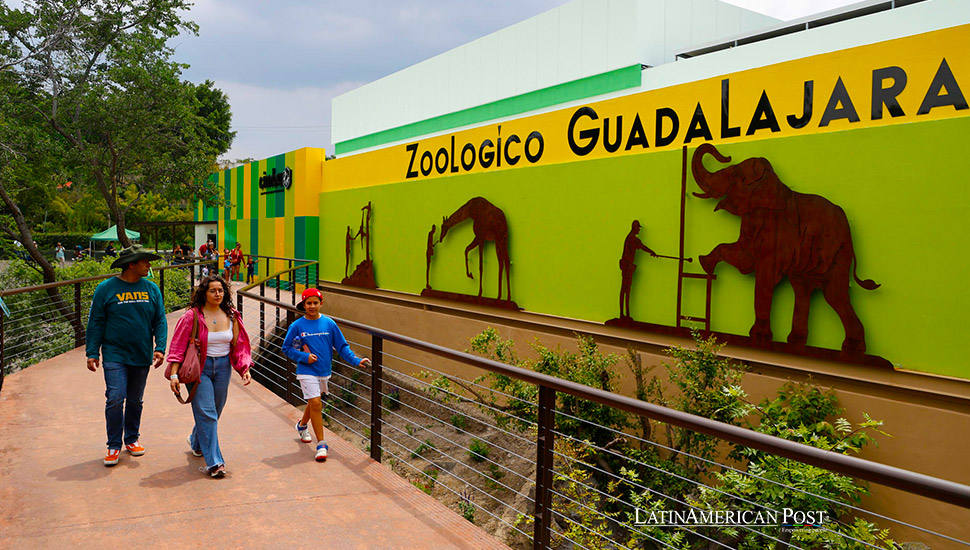Inside Guadalajara, Mexico Zoo’s Transparent Veterinary Hospital

Guadalajara Zoo in Mexico opens its veterinary hospital to the public. The hospital provides real-time medical care and surgeries for various species, fosters transparency, and educates visitors on animal care and preservation.
In a groundbreaking move, Guadalajara Zoo in Jalisco, Mexico, has opened its veterinary hospital to the public. This initiative allows visitors to witness real-time medical procedures and surgeries on various animal species. The zoo aims to promote transparency and educate the public on the importance of animal care and preservation, showcasing the respect and dignity of these procedures.
Separated only by a glass window, visitors can observe specialists in biology and veterinary medicine attending to over 300 species of animals. This initiative, as explained by the zoo’s director, Luis Soto, is designed to give the public insight into the meticulous care and preservation efforts undertaken by the zoo. “We want people to see everything that happens here. We do our best to provide the best possible care for the animals, and we decided to open our doors to everyone so there is no doubt about our great work,” Soto told EFE.
The decision to open the veterinary hospital to the public comes after several incidents that have reignited the debate over the ethical implications of keeping certain species in captivity. Notably, the deterioration of a wolf named Seje at the Chapultepec Zoo in Mexico City and the death of a lioness in Hidalgo due to lack of medical attention has raised concerns about the treatment of animals in zoos across the country.
Soto emphasized that modern zoos play a crucial role in conservation, offering many species a chance to survive and reproduce. He noted that 70% of the 300 species at Guadalajara Zoo are endangered or threatened due to habitat invasion. “Modern zoos are institutions that carry out actions to give these species a chance. For many of these species, the zoo is their last opportunity to avoid extinction,” Soto explained.
The veterinary hospital, officially known as the Center for Integral Medicine and Animal Welfare, provides an unprecedented opportunity for the public to see the comprehensive care provided to the animals. From medical check-ups to X-rays, clinical analyses, and surgeries on animals as large as giraffes and elephants, visitors can witness the extensive efforts made to ensure the health and well-being of the zoo’s inhabitants.
Educational and Interactive Experiences
In addition to observing medical procedures, visitors can learn about the dietary planning for over 6,000 terrestrial and marine animals. The zoo’s dietitians design specific meal plans tailored to the nutritional needs of each species. Furthermore, visitors can see how the zoo stimulates the animals’ physical and mental health by providing various activities and environmental enrichment.
The open hospital also serves as a hub for collaboration with other institutions. In exceptional cases, specialists in biology and veterinary medicine nationwide are invited to participate, ensuring the animals receive the best possible care. The zoo also collaborates with social and governmental organizations to rescue and rehabilitate wild animals that require medical intervention.
This initiative aims to foster a deeper understanding and appreciation of the complexities involved in animal care and conservation. By making the process transparent, the zoo hopes to dispel any misconceptions about the treatment of animals in captivity and highlight the critical role zoos play in preserving biodiversity.
The initiative at Guadalajara Zoo is part of a broader movement in Latin America to enhance transparency and improve animal welfare standards in zoos. Across the region, there is a growing recognition of the importance of zoos as conservation centers and their role in educating the public about wildlife preservation.
Similar efforts are being made in countries like Argentina, Brazil, and Colombia to open veterinary facilities to the public and improve animal care. These initiatives are crucial in addressing the concerns raised by animal rights activists and ensuring that zoos continue to evolve as centers of conservation and education.
For instance, the Buenos Aires Eco-Park in Argentina has implemented a program that allows visitors to observe animal care procedures and learn about the park’s conservation efforts. Similarly, the São Paulo Zoo in Brazil has opened its veterinary hospital to the public, providing educational tours and workshops on animal health and conservation.
These regional efforts are improving animal care standards and fostering a culture of conservation and responsibility among the public. By making the work of veterinarians and biologists visible, zoos across Latin America are helping to build a more informed and engaged society that values and protects its natural heritage.
The Role of Zoos in Modern Conservation
Modern zoos are much more than places for public entertainment; they are critical players in the global effort to conserve endangered species. As natural habitats continue to shrink due to human activities, zoos provide a sanctuary for species that might otherwise face extinction. They serve as genetic reservoirs, maintaining diverse populations that can be reintroduced into the wild.
Guadalajara Zoo’s commitment to transparency and education models how zoos can balance public engagement with their conservation missions. By opening its veterinary hospital, it is improving the care provided to its animals and educating the public about the importance of preserving biodiversity.
Moreover, these efforts highlight the interconnectedness of human and animal health. The welfare of zoo animals is directly linked to broader environmental issues, such as pollution and habitat destruction. By raising awareness about these connections, zoos can inspire visitors to take action in their own lives to protect the environment.
While opening the veterinary hospital at Guadalajara Zoo is a significant step forward, there are still challenges to be addressed. Ensuring the highest animal welfare standards requires continuous facility investment, staff training, and collaboration with international conservation organizations.
Additionally, there is a need to balance transparency with the privacy and well-being of the animals. While public observation can be educational, it is essential to ensure it does not cause undue animal stress. Zoos must carefully manage these interactions to ensure that the primary focus remains on the health and welfare of the animals.
Looking ahead, Guadalajara Zoo plans to expand its educational programs and collaborate with other institutions to enhance its conservation efforts further. The zoo aims to develop more interactive exhibits and workshops that engage visitors in hands-on learning about wildlife and conservation.
By continuing to innovate and improve, Guadalajara Zoo can serve as a model for other zoos in Latin America and beyond. Their commitment to transparency, education, and animal welfare sets a high standard for the industry and demonstrates the vital role that modern zoos play in preserving our planet’s biodiversity.
A Vision for the Future
Guadalajara Zoo’s initiative to open its veterinary hospital to the public is a pioneering effort that underscores the importance of transparency and education in modern conservation. By allowing visitors to witness the care and dedication of their veterinary team, the zoo is fostering a deeper understanding and appreciation for the complexities of animal welfare.
This initiative is part of a broader movement in Latin America to enhance the role of zoos as centers of conservation and education. As zoos across the region continue to evolve, they are helping to build a more informed and engaged society that values and protects its natural heritage.
Also read: Rising Cyber Harassment in Mexico and Its Implications for Privacy
The challenges ahead are significant, but with continued investment, innovation, and collaboration, zoos like Guadalajara can preserve biodiversity and ensure a sustainable future for all species. Guadalajara Zoo is making a vital contribution to the global effort to protect our planet’s wildlife by setting a high standard for transparency and animal care.




